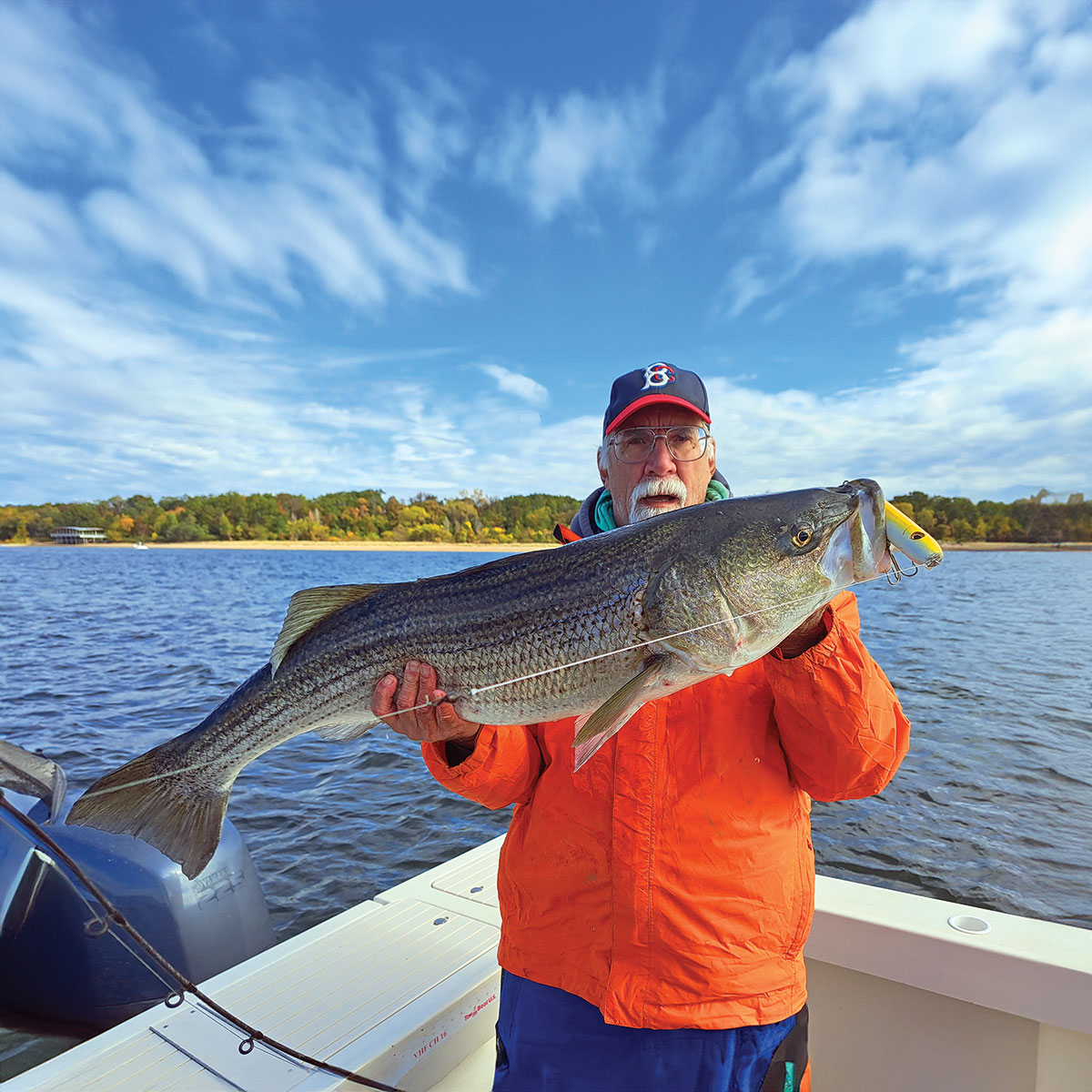
As the striper season approaches, I can’t help but think back to a conversation I had over the winter with one of my ‘surf rat’ friends. In essence, what I said – or perhaps predicted – was that as the new striped bass regulations begin to do their job, we will see an abundance of stripers in the mid-teen to 20-pound class. Although I’m no Nostradamus, I further prophesied that fish of these sizes will be easy to catch on lures; specifically topwater lures. My prediction is already coming true, even as I pound the keyboard bass are starting to pound away out there. They are stretched out for miles from points east into the bowels of Raritan Bay.
Now let’s hit the pause button for a minute and rewind the tape and throw it back to the 1960s. Sorry if you new-wave Van Staal, carbon fiber guys weren’t born yet, but indulge me for a paragraph or two. Surfcasters of that era were mythical gods in the fishing world. Equipped with heavy lumber, the infamous SB1166 11-foot Lamiglas honey yellow stick paired with the highly-coveted Crack 300. Sporting heavy rubber chest waders and surf bags that had room to hold aisle four of Herman’s Sporting Goods inside completed the arsenal. We were strong men braving the surf, wind burned with “bass hands,” the chafe from knuckles to wrists from carrying leviathan-sized cows along the sand.
Reel seats? We don’t need no stinking reel seats, we just taped our reels to the cork tape, knowing that with each wrap of the tape, we had custom-fitted our marriage of rod to reel better than anyone. Add to that the legendary artificials – we took pride in mastering each one’s technique – the lures as famous and renowned as the fishermen themselves. Nearly every reel was spooled with pink Ande monofilament, when it began to fade, it was time to re-spool. These topics burned countless hours in the tackle shops during the winter as anxious casters sifted through new shipments of blanks, testing each one, hoping to find their own, personal Excalibur.
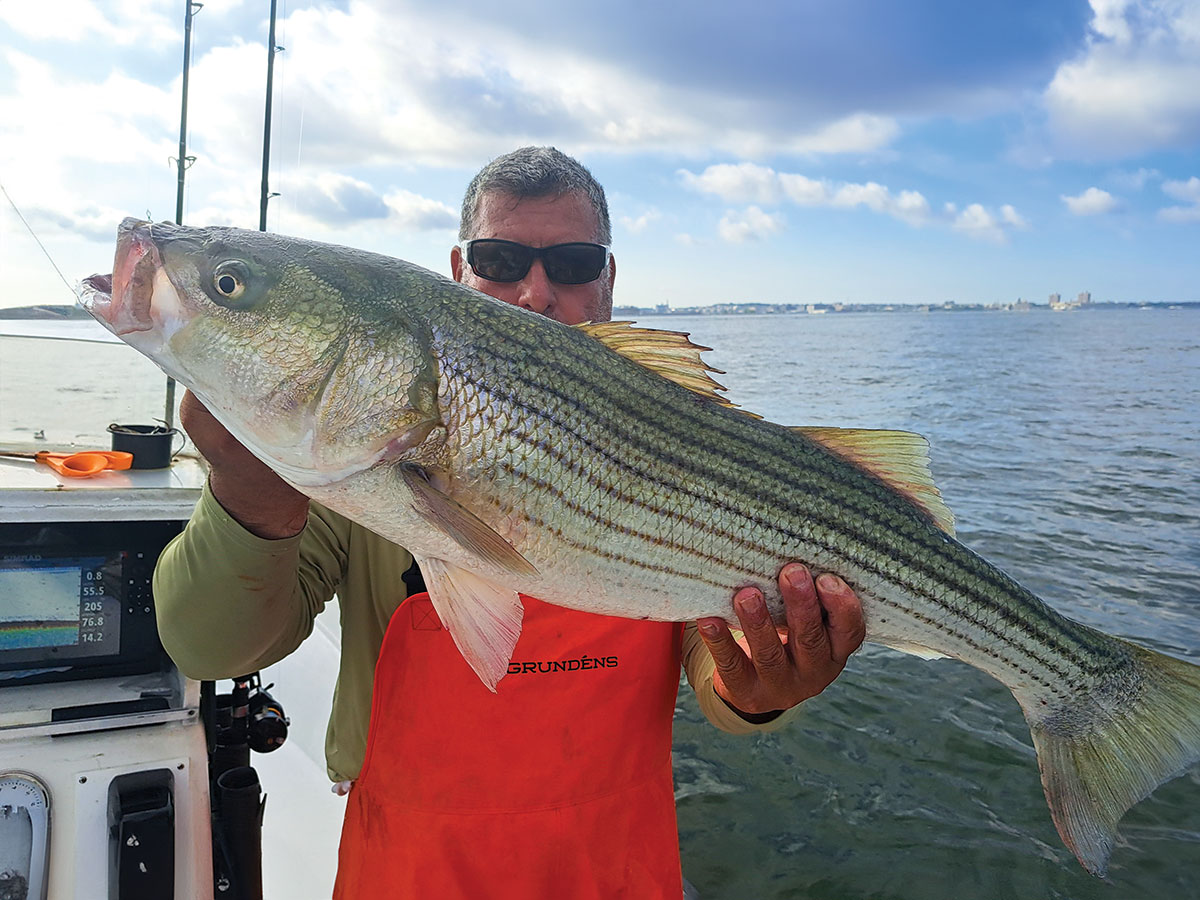
“Bassanity” Ensues
Ahh… I miss the good old days, but after fishing 55 years of this era of striped bass, this point in time rivals all of those good old days combined. Big bass are invading our waters, infesting them and it’s leading to what I refer to as ‘bassanity’ a neurological disorder. It affects surfcasters, boat anglers, purist pluggers and fly-rodders alike and no fisherman is immune to it.
As our daily lives unfold, we, like Walter Mitty, escape to the world of sripertopia. As we sit at home or at work, scheming ways to get out of everything from overtime to weddings, bar mitzvahs, and all the meaningless endeavors that interfere with the rush of endorphins a big bass exploding on a plug delivers. It’s undeniable, that boiling, slurping, tail-slapping, smashing hit, that takes down a surface plug that you drilled into the strike zone like Tom Brady threading the needle in the end zone. The plug lands, the rod jolts abruptly from a 45-degree angle to bent, and the drag zooms – yeah buddy, you’re in! And what better topwater plug than the Doc Spook to get that done? This plug, cooked up by freshwater musky fishermen, has proven itself as a striper slaying machine. It’s streamlined silhouette and loud rattles combine into something that striped bass find irresistible.
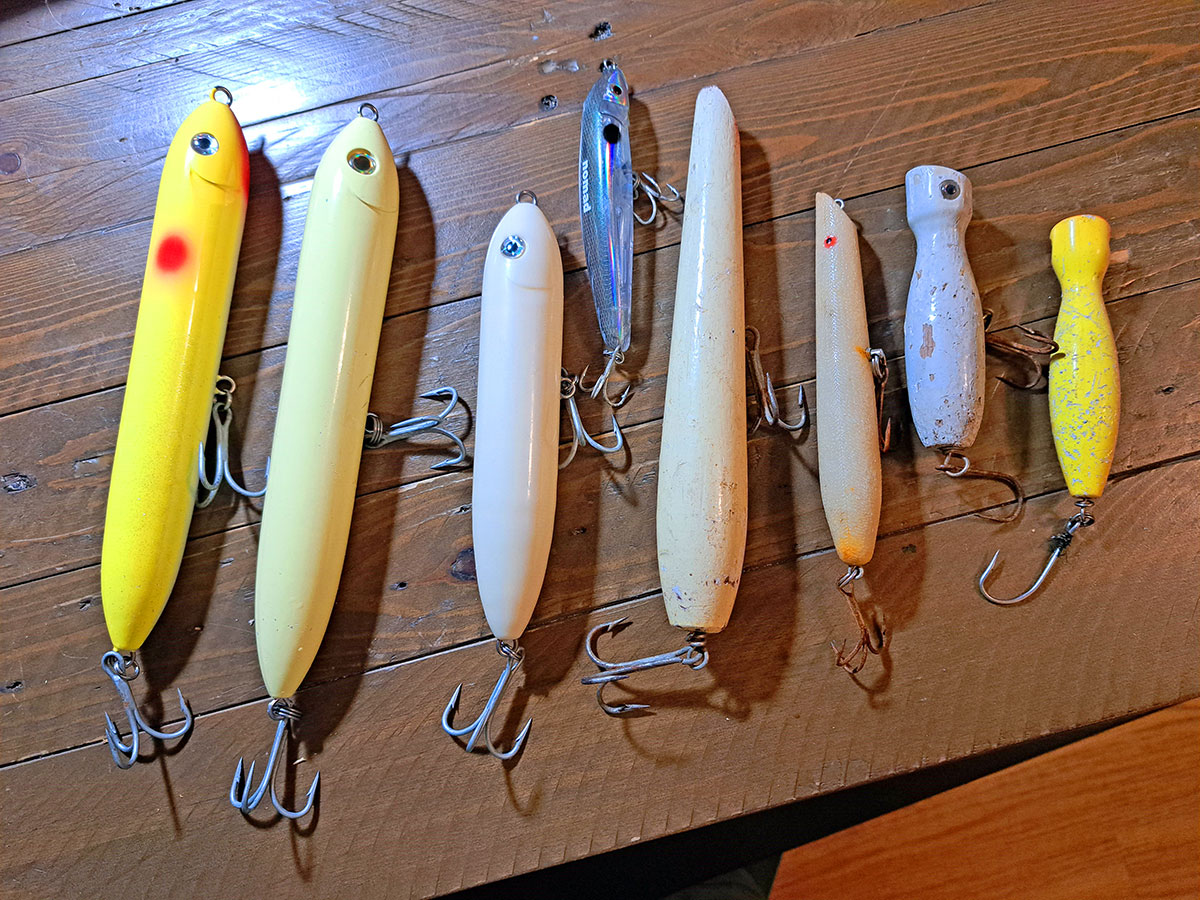
Presentation
I like topwater plugs because they test my skills on many levels, I can watch the plug and see the fish’s reaction to how I’m working it and I feel this has taught me a lot about presentation and what can make a striper commit to the strike. Since these lures are often tossed at surface feeding fish, one must always be in stealth mode. Stealthy and patient, so all of you rocket ships with triple outboards keep that in mind. I’ve had these guys zoom in and put down feeding fish too many times to count, I’m guessing you have too.
I usually approach fish, so I am casting downwind (wind at my back), especially if it’s a little snotty. This accomplishes several things: a longer cast, more time as you drift with your lure in the zone and more often with better action, too. Spook-type lures, for the most part, like flatter water; however, some newer variations that are a bit more streamlined will work as well, if not better, in rougher conditions. My friend Joe G, who turns out his own plugs, makes one that is unbelievable. The Doc is one of the few lures I know that will get attacked even when still, but that side-to-side walking the dog action seems to be the best method.
If you have spent the better part of your life watching bunker, it’s easy to see why these lures are so effective. One very basic tip I can offer is to vary your retrieve and the cadence of the walking to find what the fish want. Watch for boils and swirls and then read the tenacity or lack of it, and adjust the rhythm and speed of the lure accordingly. Do this a few thousand times, and you will be a true Jedi.
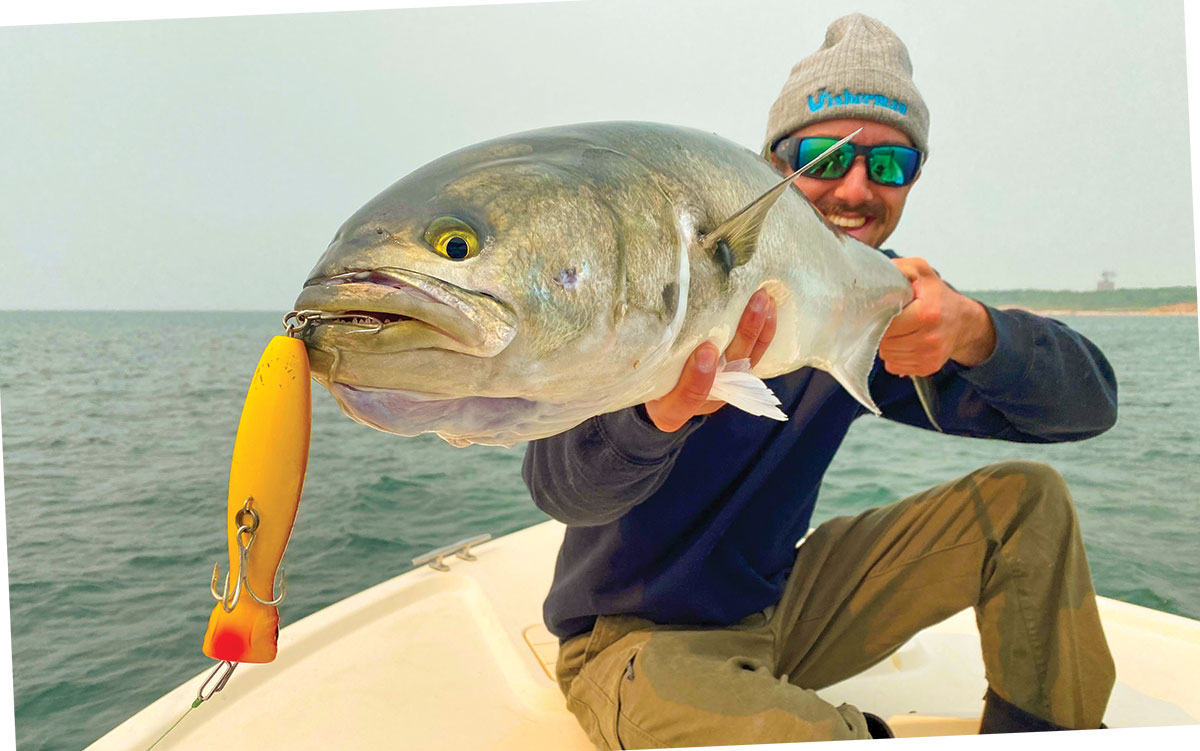
A Doc Decision
When is a Doc or other spook-style lure the right choice and when is it not? Several factors enter into this equation; wind, sea conditions and the ability of the angler are three that lead the way. There are times when a Doc is just not the best choice. This is when other topwater noise makers might be a better option, like the Polaris or ‘little neck’ style popper or the tried and true Pencil Popper. Every surfcaster was weaned on the Pencil Popper and it’s something that every daytime surfcaster has in his bag, regardless of time of year. I used to live and die by them until I got addicted to the Doc.
The Pencil Popper was invented by Stan Gibbs and is still the bar by which all others are measured. Designed for use in the Cape Cod Canal, this lure would work it’s magic while ‘going with the flow’. Cast up-tide to 10 o’clock the lure would work with the tide until about the 2 o’clock position. These wooden plugs were the weapons of choice for surfcasters of the golden age, and each would have its own personality based on wood density, grain and how well it was waterproofed; so most of us kept many at the ready. Some would get waterlogged and need to be dried out, molded plastics solved that and, to some extent, were an improvement. Some newer versions are not as streamlined and have a more pronounced cup that throws more water. Some rattle, some don’t but one thing is for sure, the colors on those mass produced plastic versions are truly mesmerizing.
Moving on to the Polaris, Super Strike has the market cornered with their Little Neck Popper that comes in three sizes and several weights. They perform well, have good hardware, and, like the previously mentioned lures, catch fish. Polaris types throw a lot of water, and when the situation calls for something noisy, they catch a ton of fish. Donny Musso has come a long way from selling plugs out of the back of his K-5 blazer on the Cape.
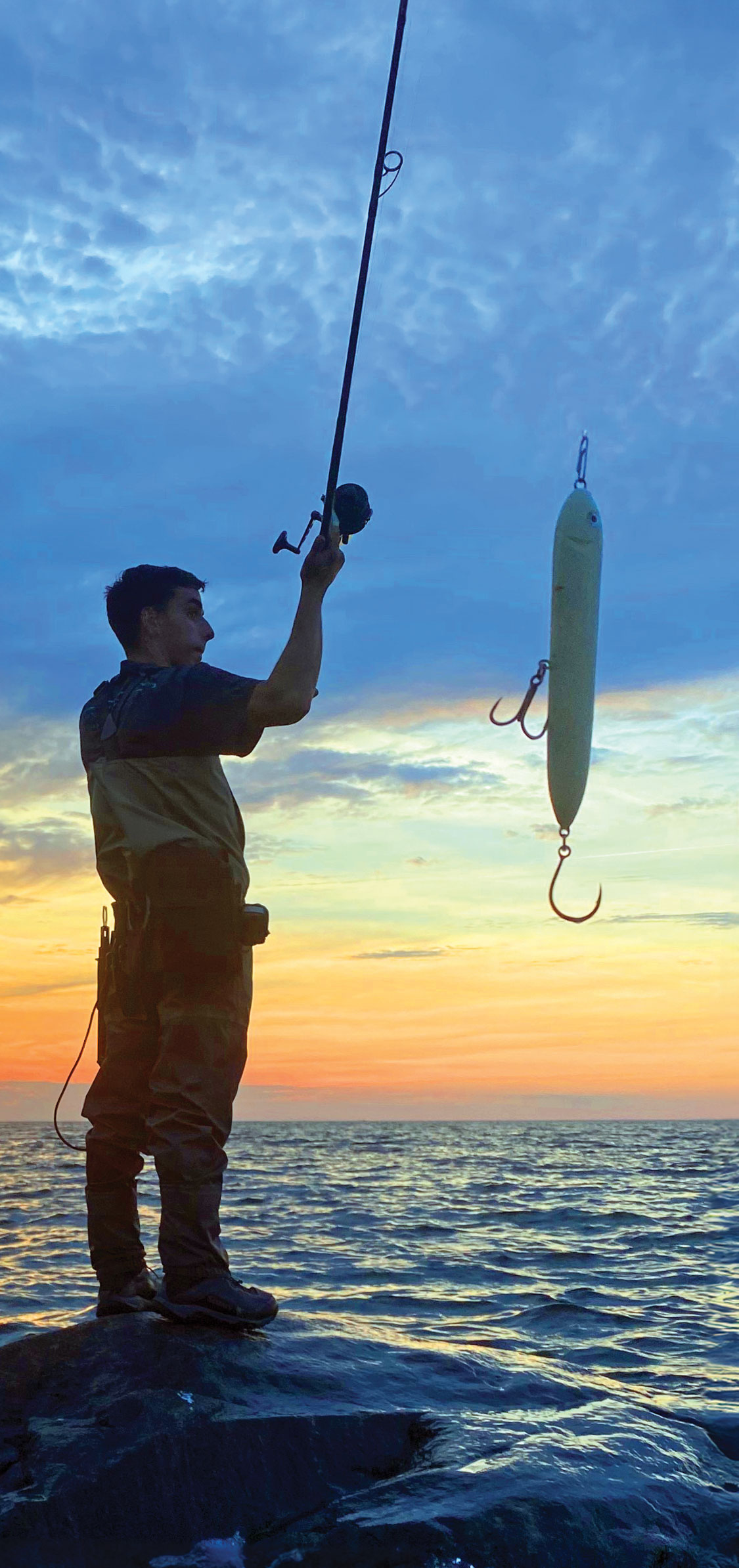
Tactical Gear
| CHANGING HARDWARE |
| You can also change the split rings and hooks on some of these lures, especially if you’re a big fish enthusiast. Look for rings with at least a 100-pound breaking strength. Most lures come equipped with treble hooks and swapping out to inline singles will help with safer release practices as well.
Single Hook Recommendations:
|
So, when going into battle, you need the proper gear. Rod selection is a key component when waging war with big bass. The rod needs to be a fairly decent piece of lumber. Seven-to-eight-foot sticks or better on a boat. The rod needs sufficient backbone to toss these bad boys, yet it also limber enough to impart good action to the plug. Remember, some of these plugs weigh over 3 ounces. I like smaller butt ends because I can keep the rod low and have good control as I sweep it with my wrist. A light stick is the way to go, especially if you are casting for hours, likewise with reel and line selection; a 4000- to 5000-sized spinner will be light enough and will pair perfectly with a 7- to 8-footer. As far as surf rods go, 9 to 10 feet is a good length for efficiently working a popper and being able to control a Doc. The rods of today, custom or off the rack, are far superior to the Frank Woolner telephone poles of the 50s. For line, 20-pound test braid is my standard. A lighter line and longer cast equals more area covered. And if you have the drag on your reel set properly, you should have no issues controlling or landing any striper. And, take it from me, keep your drag on the lighter side to reduce the leverage a big fish can get on your hooks.
So the art of plugging will not only add to your journey as a fisherman, it will give you a different slant or perspective on this truly great resource. Add these lures to your arsenal and whether in the back bay, surf, boat, or river, you will find a time when you can use them.
The author runs Karen Ann charters on Jamaica Bay in New York.




